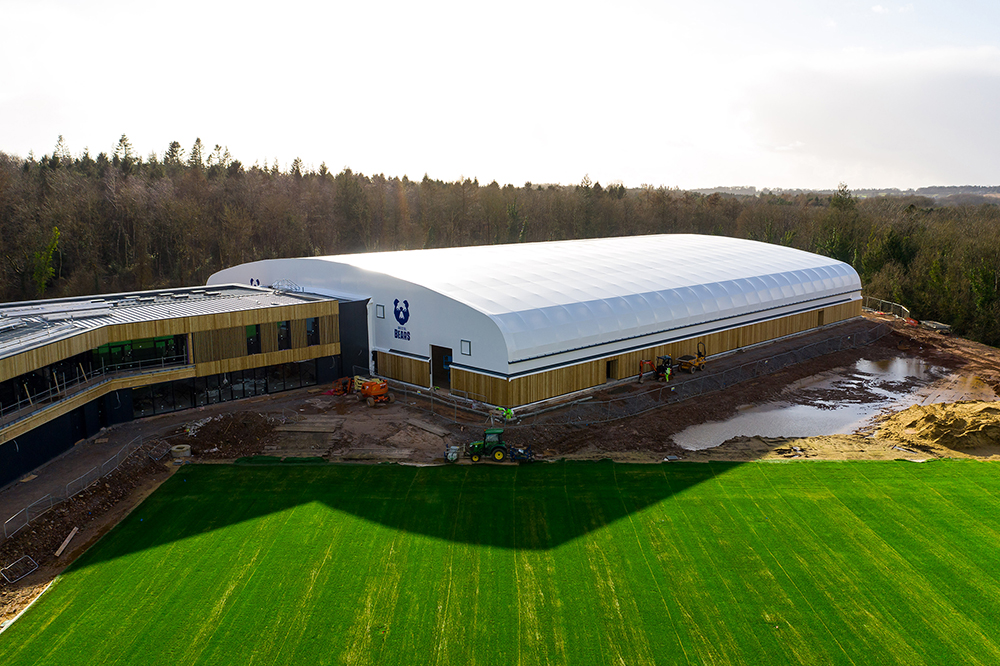Tensile Fabric Structures vs. Inflatable Air Domes: A Stronger, Safer Choice

Recent storms across various regions have highlighted a significant issue in the world of sports facilities: the vulnerability of inflatable air domes to extreme weather. The damage and destruction to some air domes due to high winds and snow have reinforced the risks associated with these temporary structures. As clubs seek alternatives, tensile fabric structures have proven to be the superior, long-term solution.
Disclaimer: The information presented in this article represents the views and opinions of Collinson Tensile based on industry knowledge and recent events. It is intended for informational purposes only and is not meant to discredit any specific air dome supplier or manufacturer.
The Risks of Inflatable Air Domes in Extreme Weather
Inflatable air domes, while cost-effective and quick to install, have several critical weaknesses when it comes to adverse weather conditions:
- Susceptibility to High Winds – Many air dome suppliers claim that increasing internal pressure can counteract the effects of storms. However, this is a flawed approach. In reality, high winds exert unpredictable lateral forces that pressure adjustments cannot fully mitigate, leading to structural failure or even catastrophic collapse.
- Snow Load Challenges – The collapse of air domes under heavy snowfall demonstrates how accumulation can be a major issue. Air domes rely on continuous air pressure to maintain their shape, but when excessive snow weight builds up, the structure can buckle, leading to sudden failures.
- Deflation as a Last Resort – Some air dome suppliers suggest deflating the structure ahead of extreme weather as a preventative measure. However, this leaves the facility entirely unusable and unprotected, essentially rendering it useless when it is most needed. Moreover, re-inflating and repairing any damage post-storm can be time-consuming and costly.
Tensile Fabric Structures: A Resilient Alternative
Tensile fabric buildings, in contrast, offer a far more reliable and durable solution for sports clubs and organisations looking for all-weather facilities. Here’s how they compare:
- Engineered for Extreme Weather – Unlike air domes, our tensile fabric structures are designed with robust lattice steel frames, ensuring they remain structurally sound even in high winds or heavy snow loads.
- No Dependence on Air Pressure – Because our tensile structures do not rely on continuous air pressure, they eliminate the risk of catastrophic collapse due to power failure, pressure loss, or external forces.
- Longevity and Cost-Effectiveness – While air domes often require ongoing maintenance and potential replacement due to weather damage, our tensile structures are built to last for decades with minimal upkeep, making them a more cost-effective investment in the long run.
- Fully Enclosed – Tensile buildings are fully enclosed providing an airtight environment which can be mechanically ventilated or dehumidified to provide the correct playing environment and conditions to keep the steel frame in good condition to ensure year-round usage, whatever the weather,
Real-World Example: Shetland Recreational Trust
A prime example of the advantages of tensile fabric structures can be found in the Shetland Recreational Trust project. Located in one of the harshest weather environments in the UK, this facility demonstrates how our tensile buildings provide durability, comfort, and long-term usability despite extreme weather conditions. Unlike air domes, which would be highly vulnerable to Shetland’s strong winds and heavy rain, this tensile building offers year-round protection for sports and recreational activities, proving to be a wise investment for the community.
Debunking Common Air Dome Claims
“Increasing Internal Pressure Prevents Collapse”
While some manufacturers claim that higher internal pressure can withstand storm-force winds, real-world failures—such as those in Ireland—prove otherwise. Extreme winds create uplift and shear forces that an air-supported structure simply cannot resist indefinitely.
“Air Domes are a Cost-Effective Long-Term Solution”
Air domes may seem like an affordable option upfront, but when factoring in storm damage, maintenance, and eventual replacement costs, they often become more expensive over time compared to a tensile structure.
“Deflating the Dome is a Safe Strategy”
This approach effectively means surrendering the facility to the storm. Once deflated, the structure provides no protection, and re-inflation post-storm can be a logistical and financial burden.
Conclusion
The destruction of air domes in recent extreme weather events underscores the need for more resilient and permanent sports facility solutions. While air domes may work in controlled environments with minimal weather exposure, they are a riskier choice for areas prone to storms, wind, and snow. Tensile fabric structures provide a stronger, more durable, and ultimately safer alternative that ensures year-round usability and peace of mind for sports clubs and organisations.
For clubs looking to upgrade from an air dome, investing in a tensile fabric structure is a smart and future-proof decision. Contact Collinson Tensile today to explore your options and build a sports facility that will stand the test of time.
